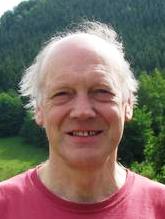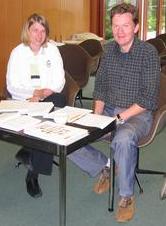In mathematics, the Thue–Morse sequence, or Prouhet–Thue–Morse sequence, is the binary sequence obtained by starting with 0 and successively appending the Boolean complement of the sequence obtained thus far. The first few steps of this procedure yield the strings 0 then 01, 0110, 01101001, 0110100110010110, and so on, which are prefixes of the Thue–Morse sequence. The full sequence begins:
In abstract algebra, the free monoid on a set is the monoid whose elements are all the finite sequences of zero or more elements from that set, with string concatenation as the monoid operation and with the unique sequence of zero elements, often called the empty string and denoted by ε or λ, as the identity element. The free monoid on a set A is usually denoted A∗. The free semigroup on A is the subsemigroup of A∗ containing all elements except the empty string. It is usually denoted A+.
In mathematics and theoretical computer science, an automatic sequence (also called a k-automatic sequence or a k-recognizable sequence when one wants to indicate that the base of the numerals used is k) is an infinite sequence of terms characterized by a finite automaton. The n-th term of an automatic sequence a(n) is a mapping of the final state reached in a finite automaton accepting the digits of the number n in some fixed base k.
Florence Nightingale David, also known as F. N. David was an English statistician. She was head of the Statistics Department at the University of California, Riverside between 1970 – 77 and her research interests included the history of probability and statistical ideas.
The mathematical disciplines of combinatorics and dynamical systems interact in a number of ways. The ergodic theory of dynamical systems has recently been used to prove combinatorial theorems about number theory which has given rise to the field of arithmetic combinatorics. Also dynamical systems theory is heavily involved in the relatively recent field of combinatorics on words. Also combinatorial aspects of dynamical systems are studied. Dynamical systems can be defined on combinatorial objects; see for example graph dynamical system.
Combinatorics on words is a fairly new field of mathematics, branching from combinatorics, which focuses on the study of words and formal languages. The subject looks at letters or symbols, and the sequences they form. Combinatorics on words affects various areas of mathematical study, including algebra and computer science. There have been a wide range of contributions to the field. Some of the first work was on square-free words by Axel Thue in the early 1900s. He and colleagues observed patterns within words and tried to explain them. As time went on, combinatorics on words became useful in the study of algorithms and coding. It led to developments in abstract algebra and answering open questions.

Geoffrey Richard GrimmettOLY is a mathematician known for his work on the mathematics of random systems arising in probability theory and statistical mechanics, especially percolation theory and the contact process. He is the Professor of Mathematical Statistics in the Statistical Laboratory, University of Cambridge, and was the Master of Downing College, Cambridge, from 2013 to 2018.
In computer science, the complexity function of a word or string is the function that counts the number of distinct factors of that string. More generally, the complexity function of a formal language counts the number of distinct words of given length.
M. Lothaire is the pseudonym of a group of mathematicians, many of whom were students of Marcel-Paul Schützenberger. The name is used as the author of several of their joint books about combinatorics on words. The group is named for Lothair I.
In mathematics and computer science, a morphic word or substitutive word is an infinite sequence of symbols which is constructed from a particular class of endomorphism of a free monoid.
In mathematics, a sesquipower or Zimin word is a string over an alphabet with identical prefix and suffix. Sesquipowers are unavoidable patterns, in the sense that all sufficiently long strings contain one.
In mathematics, a recurrent word or sequence is an infinite word over a finite alphabet in which every factor occurs infinitely many times. An infinite word is recurrent if and only if it is a sesquipower.
In mathematics, in the field of tropical analysis, the log semiring is the semiring structure on the logarithmic scale, obtained by considering the extended real numbers as logarithms. That is, the operations of addition and multiplication are defined by conjugation: exponentiate the real numbers, obtaining a positive number, add or multiply these numbers with the ordinary algebraic operations on real numbers, and then take the logarithm to reverse the initial exponentiation. Such operations are also known as, e.g., logarithmic addition, etc. As usual in tropical analysis, the operations are denoted by ⊕ and ⊗ to distinguish them from the usual addition + and multiplication ×. These operations depend on the choice of base b for the exponent and logarithm, which corresponds to a scale factor, and are well-defined for any positive base other than 1; using a base b < 1 is equivalent to using a negative sign and using the inverse 1/b > 1. If not qualified, the base is conventionally taken to be e or 1/e, which corresponds to e with a negative.

Dominique Pierre Perrin is a French mathematician and theoretical computer scientist known for his contributions to coding theory and to combinatorics on words. He is a professor of the University of Marne-la-Vallée and currently serves as the President of ESIEE Paris.
Jean Berstel is a French mathematician and theoretical computer scientist known for his contributions to combinatorics on words and formal language theory. He is a currently a professor emeritus at the University of Marne-la-Vallée.
Magda Peligrad is a Romanian mathematician and mathematical statistician known for her research in probability theory, and particularly on central limit theorems and stochastic processes. She works at the University of Cincinnati, where she is Distinguished Charles Phelps Taft Professor of Mathematical Sciences.

Valérie Berthé is a French mathematician who works as a director of research for the Centre national de la recherche scientifique (CNRS) at the Institut de Recherche en Informatique Fondamentale (IRIF), a joint project between CNRS and Paris Diderot University. Her research involves symbolic dynamics, combinatorics on words, discrete geometry, numeral systems, tessellations, and fractals.
Christina Anna Goldschmidt is a British probabilist known for her work in probability theory including coalescent theory, random minimum spanning trees, and the theory of random graphs. She is professor of probability in the department of statistics, University of Oxford and a fellow of Lady Margaret Hall, Oxford.
Sophie Schbath is a French statistician whose research concerns the statistics of pattern matching in strings and formal languages, particularly as applied to genomics. She is a director of research for the French National Institute for Research in Agriculture, Food, and Environment (INRAE), and a former president of the French BioInformatics Society.
Véronique Bruyère is a Belgian computer scientist working in automata theory, temporal logic, and combinatorics on words, among other topics. She is a professor of computer science at the University of Mons in Belgium.



